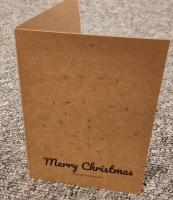Blog
Christmas card 2024
2024-12-04
As usual, I spent some time this November,
designing this year's Chalkdust puzzle Christmas card
(with some help from TD).
The card contains 10 puzzles. By splitting the answers into pairs of digits, then drawing lines between the dots on the cover for each pair of digits (eg if an answer is 201304, draw a line from dot 20 to dot 13 and another line from dot 13 to dot 4), you will reveal a Christmas themed picture. Colouring any region containing an even number of unused dots green and colour any region containing an odd number of unused dots red or blue will make the picture even nicer.
If you're in the UK and want some copies of the card to send to your maths-loving friends, you can order them at mscroggs.co.uk/cards.
If you want to try the card yourself, you can download this printable A4 pdf. Alternatively, you can find the puzzles below and type the answers in the boxes. The answers will automatically be used to join the dots and the appropriate regions coloured in...
| 1. | What is the largest number you can make by using the digits 1 to 4 to make two 2-digit numbers, then mutiplying the two numbers together? | Answer |
| 2. | What is the largest number you can make by using the digits 0 to 9 to make a 2-digit number and a 8-digit number, then mutiplying the two numbers together? | Answer |
| 3. | The expansion of \((2x+3)^2\) is \(4x^2+12x+9\). The sum of the coefficients of \(4x^2+12x+9\) is 25. What is the sum of the coefficients of the expansion of \((30x+5)^2\)? | Answer |
| 4. | What is the sum of the coefficients of the expansion of \((2x+1)^{11}\)? | Answer |
| 5. | What is the geometric mean of all the factors of 41306329? | Answer |
| 6. | What is the largest number for which the geometric mean of all its factors is 92? | Answer |
| 7. | What is the sum of all the factors of \(7^4\)? | Answer |
| 8. | How many numbers between 1 and 28988500000 have an odd number of factors? | Answer |
| 9. | Eve found the total of the 365 consecutive integers starting at 500 and the total of the next 365 consecutive integers, then subtracted the smaller total from the larger total. What was her result? | Answer |
| 10. | Eve found the total of the \(n\) consecutive integers starting at a number and the total of the next \(n\) consecutive integers, then subtracted the smaller total from the larger total. Her result was 22344529. What is the largest possible value of \(n\) that she could have used? | Answer |
(Click on one of these icons to react to this blog post)
You might also enjoy...
Comments
Comments in green were written by me. Comments in blue were not written by me.
Matt, great card this year! Problems 1 and 2 are slightly ambiguous though in that you did not specify that each digit could only be used once.
I initially thought the answers were simply 44×44 = 1936 and 99×99999999 = 9899999901, respectively ????
I initially thought the answers were simply 44×44 = 1936 and 99×99999999 = 9899999901, respectively ????
Dan Whitman
I find that I can enter seven correct answers without issue. however, an eighth answer causes the entire tree to vanish.
I'm using Firefox on Windows 11.
I'm using Firefox on Windows 11.
hakon
@HJ: I can't reproduce that error on Firefox or Chrome on Ubuntu - although I did notice I'd left some debug outputting on, which I've now removed. Perhaps that was causing the issue.
If anyone else hits this issue, please let me know.
If anyone else hits this issue, please let me know.
Matthew
On my machine (Mac, using either Firefox or Chrome, including private mode so no plugins) the puzzle disappears when I complete the answers for 1, 3 and 9. I'm presuming my answers are correct -- the pattern they create is pretty clear and looks reasonable.
HJ
Add a Comment






Happy New Year! Greetings from Ukraine.